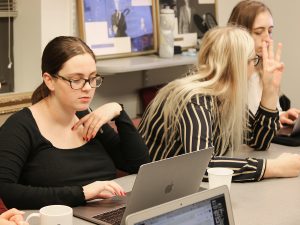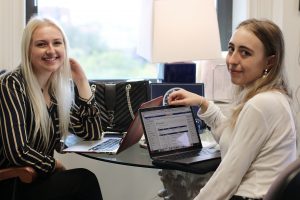Midterm Marathon: Emerson Polling’s Whirlwind Week of Data Analysis
Emerson Polling students analyze data for an upcoming poll release on Tuesday, October 30. The students are releasing 19 polls in the week leading up to the midterm elections. Photo/Claire Richards ’22
By Erin Clossey
Nineteen states in eight days.
In the wild week before the midterm elections, as candidates take off their gloves, Emerson College Polling students roll up their sleeves, cranking out analysis with machine-like precision. This Monday through Friday, Emerson Polling is releasing three polls a day, looking at some of closest watched congressional and gubernatorial races in the country.
As of this writing, they’ve asked voters in New Jersey, Michigan, New Mexico, Kansas, Oregon, Ohio, Connecticut, Maine, New Hampshire, Tennessee, Texas, and West Virginia. On Friday, they’ll examine Wisconsin, Georgia, and Iowa, and the grand finale will be Monday night during Talk the Vote, a special broadcast of WBZ’s Night Side with Dan Rea from the Bordy Theater. That’s when Emerson Polling’s advisor, Assistant Professor Spencer Kimball, will reveal the results of red hot races in four states: Nevada, Arizona, Florida, and Missouri.
“It’s kind of trial by fire,” Kimball said. “I like to say that pressure makes diamonds, and so [on Tuesday night] we will have, God willing, a gem in our crown.”
The polls, which have been recognized nationally for their accuracy and innovative methodology, are done primarily by 22 Emerson students, with guidance from Kimball.

Students come up with the survey instruments, make sure they’re set up properly on Survey Monkey (online polls) and Stratics (automated phone calls to landlines), and analyze all the data once it’s returned.
Each poll takes about a week, from beginning to end, said Emerson Polling Co-President Isabel Holloway ’19, with the analysis taking about two days. Although on November 1, they have just a few hours to comb through the numbers before they discuss it on Emerson Polling’s Student Roundtable podcast at 4:30 pm.
Oh yeah, they do a weekly podcast too.
They came up with the states to poll, and the order in which to poll them, based on the competitiveness of the races, saving the biggest nail biters for last.
Missouri, a Red State where Sen. Claire McCaskill, a two-term Democrat, is facing a tough challenge from Republican Attorney General Josh Hawley, will be one of the final polls released on November 5. Emerson Polling member Nicklas Hinsch ’20 will be watching the outcome of that race with particular interest.
Not only has he been polling the contest since last spring, he also worked as an organizer on the McCaskill campaign over the summer. Last semester, Emerson polls showed McCaskill and Hawley in a dead heat.
“I’m pretty nervous about it because if she loses, I’ll be like, ‘Oh I should’ve called up more people,’” Hinsch said. “I’m excited to see how it ends up.”
Holloway, the Emerson Polling co-president, said as the midterms have heated up, she and other members of the group have been peppered with questions from family and friends wanting to know what’s going to happen on November 6.
She tells them to wait and see.
“A lot of [the races] are tossups,” Holloway said. “If it’s within the margin of error, we can’t say either way.”

Crunching and analyzing data is heavy on math, which many Emerson students would not count as their favorite subject, Co-President Elizabeth Rattoballi ’20 said, but there can be factors in any race that the numbers don’t show.
Predicting the youth vote is especially tricky, she said, particularly in states with strict voter ID laws.
“In Texas [Sen. Ted Cruz (R) vs. Beto O’Rourke (D)], for example, there’s a lot of youth excitement, but it’s also still hard to vote in Texas, so people who are voting for the first time might be upset with long wait times [and give up],” Rattoballi said.
And then there are the numbers that catch them off guard. In polling New Jersey voters, the students found Sen. Bob Menendez, who was indicted on federal corruption charges in 2015 (his trial ended in a mistrial in 2017), had just a 34 percent favorability rating. Yet he was leading his challenger, Republican Bob Hugin, by 5 percentage points—thin, but still outside the 4 percent margin of error.
If each state’s voting law (or voter) idiosyncrasies can confound data, so can methodologies. Landline surveys, which tend to reach older voters, can skew Republican, but Emerson Polling’s online component is better at capturing younger, more Democratic voters, balancing things out, Hinsch said.
So far, Emerson Polling’s methodology has seemed to work out pretty well. Last semester, poll analysis and politics website FiveThirtyEight called Emerson a “pollster to trust,” ranking them as the second-most accurate out of 19 prolific pollsters since the November 2016 election. That list included other universities, as well as market research companies like Rasmussen Reports and Opinion Research Corp.
That’s the most exciting part of Emerson Polling for Hinsch: when a poll he’s worked on is talked about by analysts from major media outlets, even if it’s someone questioning Emerson’s results or methods.
“Whether good or bad, a lot of people are seeing this, and it’s something I worked on,” Hinsch said. “That’s pretty cool to me.”
Categories